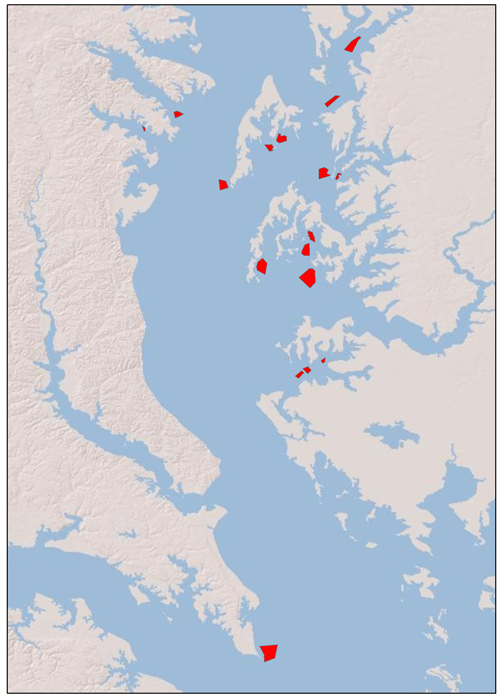Q. Why are you creating more sanctuaries when we need more fishable areas?
A. Sanctuaries are needed to protect the broodstock of the oyster population. The spat these oysters produce will re-seed nearby oyster grounds and will be the source of the harvest of the future. Oyster sanctuaries also provide critical ecosystem services, increasing water quality and clarity and providing habitat. Furthermore, oyster reefs provide habitat for juvenile and adult stages of other commercially and recreationally important fishery species, including blue crabs, striped bass, tautog, drum, sea trout, flounder, sea bass, and of course, more oysters!
Top
Q. Bars need to be power dredged or they'll get smothered with silt and die. How are sanctuaries going to help?
A. Oyster bars do not need to be worked to be healthy. Many bars that have not been power dredged for decades have oyster populations as high as or higher than areas that have been power dredged.
Top
Q. Disease and pollution are the reason oyster populations are low. Why are you only targeting watermen?
A. It is true that disease has devastated oyster populations. It is also true that the pollution is harmful to oysters, particularly those in deeper water. Given the threat of disease and pollution, it is the Department's responsibility to take sensible steps to protect what remains of the oyster population.
Top
Q. These sanctuaries are big. Will there be anywhere left for a waterman to catch oysters?
A. While the acreage of sanctuaries is proposed to increase from 4% of viable oyster bars in 2008 to 24% in 2010, that will still leave 76% of bars accessible to the fishery.
Top
Q. Next year will there be even more sanctuaries and fewer places to catch oysters?
A. No. The Department values the economic and cultural benefits of having a wild oyster fishery. While small sanctuaries may be added for specific reasons, we do not anticipate another large-scale expansion of the sanctuary network in the near future.
Top
Q. Oysters in sanctuaries now just get poached. What good will more sanctuaries do if the oysters are stolen out of them?
A. Oyster theft is a serious problem. The existing sanctuaries, with small closed areas surrounded by fishable waters, were very difficult to enforce. Having large intact closures will allow enforcement to be more effective.
Top
Q. I have heard that most sanctuaries don't even have any oysters in them. If this is the case, why make more?
A. Prior to 2009, very few sanctuaries had been established in areas with productive oyster bars. Areas were chosen to minimize impact to the fishery rather than to protect viable reefs. The sanctuaries proposed for 2010 include some of the Bay's best oyster reefs. With no fishing pressure, we expect to see a jump in oyster populations in these areas.
Top
Q. How were the sanctuary network areas chosen?
A. In order to help set criteria for selecting new sanctuary areas for the Spatial Management Plan, data from the Fall Survey for 1996 - 2007 were analyzed to identify Maryland's most productive oyster bars. The Fall Survey records the number of live and dead oysters in 3 size classes for 25 regions in the Maryland portion of the Chesapeake Bay. Any oyster bar having 4 or more years of high market oyster counts (top 10% relative to the other bars) received a "best bar" designation. Some characteristics of these 17 "best bars" are that they are:
- Primarily located north of the Patuxent River;
- Primarily located on the Eastern Shore;
- Typically associated with more low and medium salinities and some type of recent rehabilitative treatment (application of dredged shell, fresh shell, and/or seed oysters);
- Concentrated most highly in the regions of Broad Creek, Little Choptank River, and Eastern Bay.
Best Bars Map
